The always-on feature called Connected Standby in Windows 8 has been updated for Windows 10. Modern Standby, as it is now known, has support for HDD-based PCs and allows you to disable WiFi during Sleep which will help preserve battery life. Windows 10 also includes easier controls for preventing applications to run in the background and for controlling notifications which also extend to a new Battery Saver mode. I’ve tested the features on a couple of Windows 10 devices (upgrades) and the results have been extremely varied. This Windows 10 feature needs more work but it’s a huge potential advantage to mobile battery life when compared to Windows 8.
Modern Standby extends Connected Standby with more flexibility for different hardware designs. PCs with rotating hard drives can now use Modern Standby in a non-connected state. As before, all desktop apps are paused. Network connectivity via WiFi, mobile broadband (MBB) and Ethernet are kept active in order for Windows Store apps be able to send and receive network data. If a PC is using MBB the system continues to search for WiFi as a ‘cheaper’ connectivity option. The guideline for MS battery usage has been removed (was 5% in 16 hours which I saw working in just a few cases out of many, many tablets that I’ve tested over the last 2 years.) but there’s now a ‘recommendation’ that a PC lasts for 9 days or longer when in MS mode.
Windows 10 Store applications can register a Background Task that allows them to run while in the MS state which is how notifications, audio streaming, app updates and other activities can continue to work in Sleep, turning a Windows 10 tablet into an always-on PC. These activities are strictly controlled through scheduling and usage limits. Background Tasks registered in the so-called Background Infrastructure are one of many ‘Activators’ that can bring the processor out of deep sleep to perform actions. Other Activators include Windows Update, audio playback, image download, geofencing settings and others. (Ref. Windows 8 Docx.)
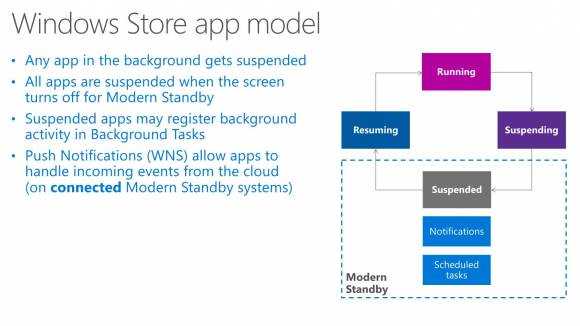
In Windows 8 you could run Skype in the background under Sleep mode and still get notifications. Music would stream during sleep and notifications from Facebook, MSN News, Twitter, Alarms and other services would also be allowed through as sound notifications but it requires a very tight hardware, device driver and software build for it all to work. In Windows 10 there’s evidence that it’s a bit broken. Updates are helping but there are still issues.
Testing Windows 10 Modern Standby
Based on my research and information from my followers it looks like Windows 10 Modern Standby Sleep is broken. Multiple Windows 10 updates aren’t helping anyone to get predictable PC behaviour and my testing proves there are problems.
One of the problems with the upgrade to Windows 10 is that there could be driver issues that prevent Modern Standby from working and I see evidence of that on two Windows 8 tablets here that have been upgraded to Windows 10. Both the Surface Pro 3 and Lenovo Thinkpad 8 enter a ‘sleep’ state but it’s rare that the deepest state (known as DRIPS – Deepest Runtime Idle Platform State) is being reached and I haven’t experienced any apps that send notifications in Modern Standby. Windows updates seem to be helping though.
Analyzing Sleep issues.
Sleep issues can be analyzed using the powercfg -energy command (executed via cmd in administrator mode) which will monitor the PC for 60 seconds and report on devices and applications that are causing sleep issues.
Analysis of the Lenovo Thinkpad 8 consistently reports that the Intel Audio driver is preventing sleep:
To see if your MS-capable tablet has entered Modern Standby recently and to see how much power it’s used, applications and OS subsystems that have registered as ‘activators’ and other deep sleep issues you need to use the command powercfg -sleepstudy which will use raw Windows 10 power measurement data and summarize it. It will also show how much CPU activity there was within a Modern Standby session. You can even dive down into the number of IP packets sent and received during a Modern Standby session.
The Thinkpad 8 had refused to register any sleep activity during my testing…until I got a Windows update which seems to have improved the situation. Cumulative Update for Windows 10 x64-based systems KB3081438 arrived just four days ago and it’s a big one. Microsoft haven’t given any details about what the update does but the sleepstudy on the Thinkpad is now showing DRIPS time, online activity and application-registered activators. This is good progress.
Unfortunately I’m not getting notifications while the Thinkpad 8 is sleeping despite there being evidence that Facebook and Tweetium are running and performing timed checks. Multiple tests so far have had the same, null result.
Action for Microsoft: The Windows Store needs to report if an app is Modern Standby capable to help users plan for network cost, privacy and battery life.
How to check average power usage during Windows 10 Sleep (MS/CS)
To get an overview of sleep states and power usage use the powercfg -sleepstate command which lists all the MS/CS sleep states and, if MS/CS is supported, shows the average power used during the session. You should be looking for sub 100 mW averages for network-off scenarios and sub 200 mW averages for network-on scenarios. If you’re seeing over 500 mW average drain during CS/MS sessions on a Windows tablet then you have a problem. Here’s an example:
In the report you can see 10 sleep states and the power those states used. #9 is acceptable at 186 mW. #6 is suspicious. Further down in this sleepstudy report you can dive-down into more information about what was happening during the sleep state.
Audio Streaming in Modern Standby.
It works, but not as it should. Local and OneDrive (remote network) files streamed perfectly through Groove Music during Sleep but there are issues. If you set the Groove Music app to disallow background time in battery-saver mode, turn on battery-saver mode and then go to ‘Sleep’ the music continues to play. If you disallow WiFi in Sleep mode it still continues to play. If you check the sleepstudy report for the period, there’s no deep sleep registered, at least in my tests on the Surface Pro 3 and Thinkpad 8.
Note: Both Windows 8 tablets were upgraded organically via Windows update or via the Insider program.
Action for Microsoft: Modern Standby needs WiFi controls, background controls and battery saver controls to be working ASAP because there have been too many cases of people waking up to a dead PC since Windows 10 launched. Ultimately we need an ‘OFF’ switch for MS too. We also need guidance from Microsoft about how these controls – Battery Saver, background settings, metered connections and other related settings are supposed to work. A blog-post at least, Microsoft because productivity, data cost and privacy are affected.
There’s a battery power issue and a data usage issue here but it also affects privacy. If I tell Facebook that it can’t run in the background I don’t expect it to have access to WiFi, location and other information while I’m moving. With mobile PCs that have cellular connections it’s even more of a potential issue.
It’s difficult to work out any logic at all in the Windows 10 world of Connected Standby, Sleep, Background apps and Power saver but from the tests I’ve done one thing is for sure, ‘background’ has nothing to do with background permissions.
Summary.
- Modern Standby is working as a deep sleep state on some tablets and I have confirmed this on the Surface Pro 3 and Thinkpad 8
- Notifications from applications when in standby is not working for me. I have one report of it working from a follower on Twitter.
- Application background settings / power-saver settings do not stop applications running in MS/CS Sleep according to my tests.
- Windows 10 Updates seem to be improving the situation and are a prerequisite before you do your own testing.
- Store applications don’t declare their MS/CS capabilities before you download and install them
- WiFi control on Sleep not working in my tests
- Audio streaming works but is not controllable as expected. (WiFi / background / metered connections.)
- Microsoft need to issue details of how MS/CS, battery saver, background task permissions and metered connections work together in MS/CS Sleep
- Powercfg can help to track down problems and to see how much power is used in MS/CS Sleep.
Connected Standby is good and Modern Standby could be better, if only the controls worked as expected. If you have a Windows 10 tablet let us know about your Sleep experiences in the comments below. Do you have an upgraded Windows 8 tablet or a new Windows 10 tablet? Do notifications work in Sleep? Can you prevent Windows Store apps from working in the background and using network resources?

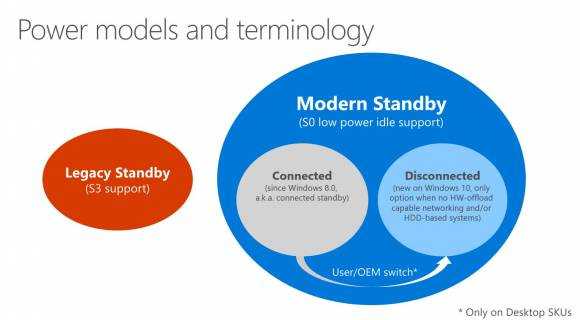
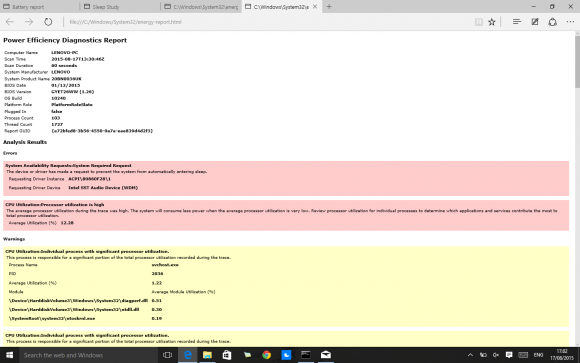
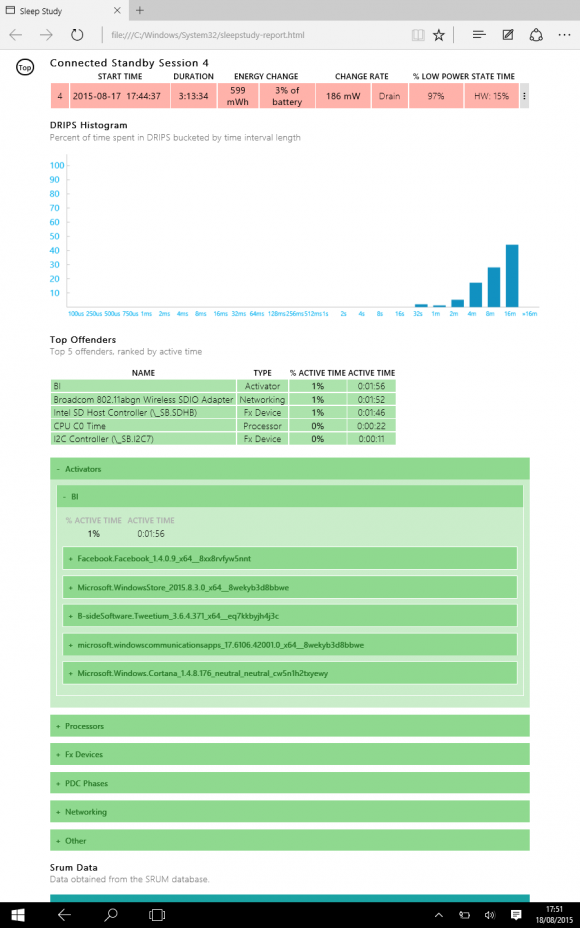
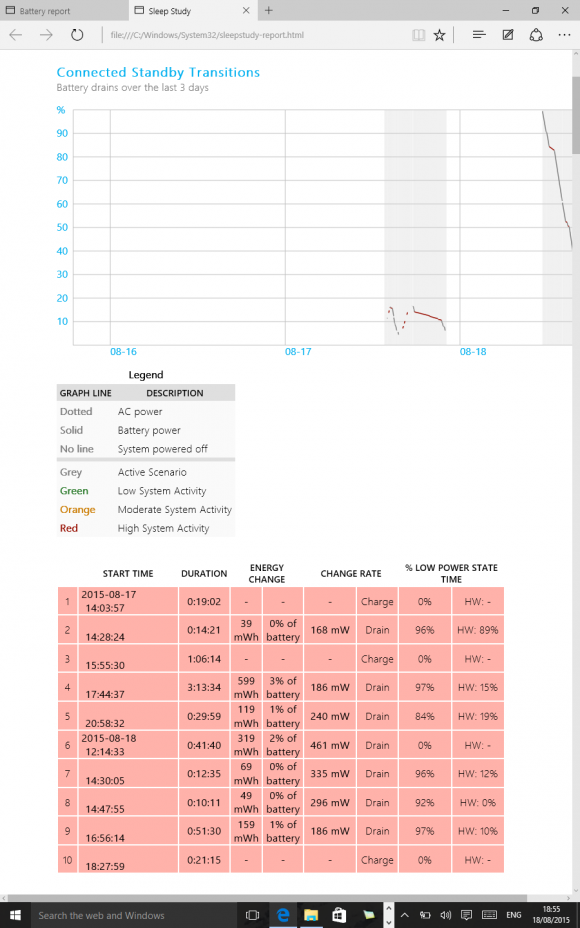










MS mode = modern standby mode
First I thought of Microsoft mode (as in MS = Microsoft :) )
I remember always having trouble staying in sleep mode or resume from sleep mode ind Win95 and Win98. (even WinXP)
I was happy when finally with WIn7 I had a PC that can use Sleep correctly.
I guess modern sleep needs some time, too.
This is really helpful thanks. My sleepstudy drain results are all over the place (from 20mW to 600+)! No DRIPS activity either, even after KB3081438. Running same platform as you (z3795).
Very nice article! Do you know it there’s any way to allow a desktop app to keep runing in background during modern standby? (There are no good modern music players, so I would like to get Media Monkey desktop app to keep playing in standby)
I use OSToto Driver Talent to solve kinds of driver related issues. I think that is one reason my computer could keep in a good condition. :)
Ive got an otherwise half decent atom powered 2 in 1 10 inch tablet that doesnt allow anything further than switching off the screen. no wake timers are enabled, and all keyboard/mouse/hid/usb hubs devices are set to not ‘allow this device to wake pc’
And yet any mode of putting the device in ‘sleep’ is immediately woken by a keypress or touchpad movement. basically a tablet that i cant use the keyboard/cover with if i want it to go to sleep.
Im slowly trying to work around it but the only ‘how to stop mouse/keyboard waking pc’ advice involves extremely basic (and already tried) ‘go to the device properties….’ and ‘check your power profile’ (devices with this sleep state only have very basic power options) tips.
Since early 2018 Modern Standby has been broken on my XPS 13. When in Modern Standby according to SleepStudy & not connected to power, it completely drains the battery in a few hours & then when I try to turn it on, consistently reports that Windows didn’t load properly & needs to restart. It is an utter failure, IMHO, after a year of great use, I now have to completely shut it down in order to avoid draining the battery when it should be hibernating. Lots of similar reports onlne.